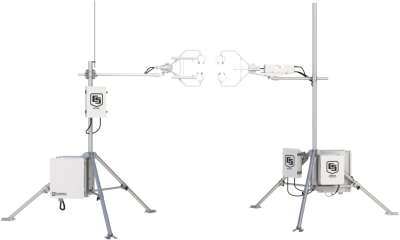We are pleased to introduce two new analyzers for measuring atmospheric levels of carbon dioxide and water vapor: the EC150 (an open-path sensor) and the EC155 (a closed-path sensor). We designed these sensors to produce high-quality measurements in the field and to work closely with our other flux system components to create fully integrated eddy-covariance flux systems.

Eddy covariance (EC) is a technique frequently used to measure the transfer of water vapor and carbon dioxide—the two most prevalent greenhouse gases—between the atmosphere and the earth’s surface. Interest in EC systems has increased over the years in parallel with concerns about climate change. While we’ve sold and supported EC systems for years, the EC150 and EC155 represent significant advancements in this area. Of particular note are the design features relevant to measurement quality and tight integration with other key EC system components.
Special consideration was given to the analyzers’ shapes, resulting in aerodynamic structures that minimize wind distortion. Their slim design, along with the reduction of internal active heat sources, minimizes error caused by the effects of analyzer body heating. Factory calibration over a wide range of pressures, temperatures, CO2 and H2O densities, and levels of window contamination further reduces measurement error.
The analyzers provide low-noise measurements and offer a broad list of diagnostic parameters to warn of questionable data. Sample rates up to 50 Hz are supported, with user-selectable bandwidths ranging from 5 to 25 Hz.
One of the most significant benefits of the sensors is their ability to fully integrate with our other measurement products to form complete eddy-covariance systems. The sensors are designed to fit well with the body of the CSAT3A, providing co-location of the gas and wind measurement volumes, critical for good eddy-covariance measurements. The two sensors also share common electronics—reducing cost, simplifying installation, and providing time synchronization between the sonic and gas measurements before the data are output to the datalogger. This level of integration has been unavailable in previous eddy-covariance systems.
Adding one of our flux-compatible dataloggers to the EC150 and CSAT3A creates a complete open-path system. A complete closed-path system requires the integration of pump, valves, datalogger, and sonic anemometer, along with the EC155. We’ve packaged all of these components into the CPEC200, a field-ready system with all the engineering done for you.
Both of the new sensors were designed to perform well in the field. They operate in harsh environments and require very little power—even the CPEC200 closed-path system with its pump and valves can operate on solar and battery power. The analyzers are field serviceable, with easy access to the chemical bottles (and sample cell in the case of the EC155) without having to dismount the sensors from the installation. The windows on both sensors are tolerant of contamination. The EC150 windows are slanted to help shed water for better performance in the rain.
We look forward to the improvements these sensors will bring to eddy-covariance measurements. For more information, please speak to a member of our Flux group.
Open-Path Versus Closed-Path Eddy-Covariance Systems
Advantages of Traditional Open-Path EC Systems:
- Simpler operation and maintenance
- Reduced power requirements
- Better frequency response
- No tube delays—better preserves temporal correlation with anemometer
Improvements Brought by the EC150 Open-Path Analyzer:
- Minimal flow distortion on anemometer
- Better spatial correlation with anemometer
- Half the power requirement of traditional open-path
Advantages of Traditional Closed-Path Gas Analyzer:
- Automated CO2 zero and span (H2O span more difficult)
- Better rain performance
- Less flow distortion on anemometer
- Density corrections for temperature not needed (maybe)
Improvements brought by the EC155 Closed-Path Analyzer:
- Significantly less flow distortion on anemometer than traditional open-path analyzer, slightly less flow distortion than aerodynamic open-path analyzer
- Less power required than traditional closed-path analyzer, more power required than open-path analyzer
- Small density corrections for temperature accomplished with thermometer in sample cell

